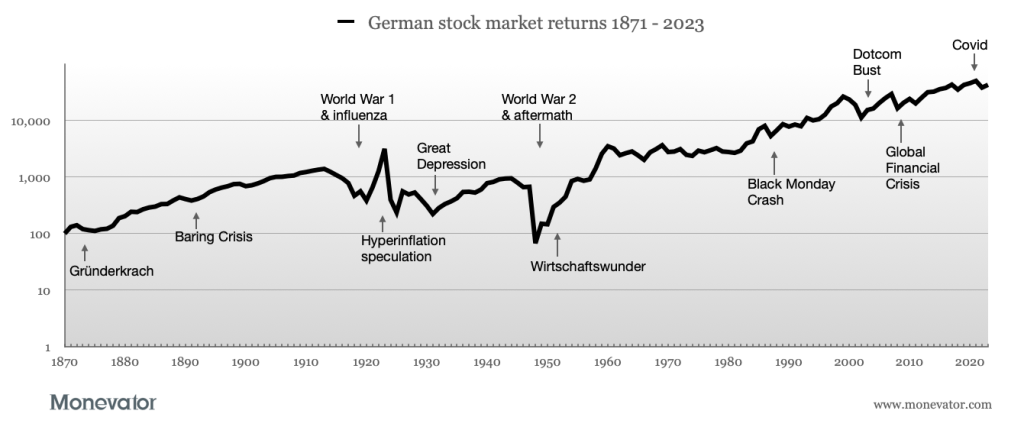
Assets do not exist in a vacuum. The late great Harry Markowitz won the Nobel prize for economics for showing that a diversified portfolio is superior to putting all your eggs in one basket.
More modestly, I’d counter that the same thing that crashed the price of index-linked gilts over the past 18 months also walloped a bunch of other assets.
The villain is, of course, the inflation surge, and the rapid ascent of interest rates in response.
Rising rates did for index-linked gilts, drowning out gains made from higher than expected inflation.
That reset was predictable (the timing and speed wasn’t) but it’s still been shocking to watch.
Every asset class whacked by rates
In fact nearly all assets took a beating in 2022 for much the same reasons.
And the pain has continued in 2023 for the most rate-sensitive assets.
The past week alone has been tough, as the City took peak rate expectations to 6.5%:
Financial markets bet on Thursday that the Bank of England will raise interest rates to a 25-year high of 6.5% early next year, up from a previous expected peak of 6.25%, pushing the yield on short-dated government bonds to their highest since mid 2008.
Rate futures showed a roughly two in three chance that the BoE will have raised rates to 6.5% or higher by its February 2024 meeting, up from 5% now.
Warren Buffett likens interest rates to gravity. That’s on account of how rates affect every aspect of finance.
Hence all assets were repriced as Bank Rate rose 20-fold from 0.25% to 5% in a year and a half.
Shares fell, naturally. Especially growth stocks.
Risk-averse investors might usually enjoy a snicker on seeing thrill-seeking equity investors getting their just deserts, but not in this crash. Safety-first investors were roughhoused just the same.
Besides index-linked gilts (aka ‘linkers’), conventional bonds – government and corporate – have been thumped. So too the supposedly boring ‘bond proxies’ invested in by those who chased higher yields, who feared a bond crash, or who preferred the hope of some growth in their paltry income and so bought dividend stalwarts like Diageo or trusts like Finsbury Growth & Income.
All down, down, down.
Normally some asset class does well in a rout. But very little has prospered for long in the declines of 2022 onwards, except for a few niches like energy stocks and UK large caps. Investors of all stripes have been carried out on their shields.
Yet for those with the appetite – and the dry powder – to sally forth once more, all this carnage also makes for opportunities.
I just wrote 6,000 words for Mogul members about index-linked gilts, for example.
And that too-vast word count was even after I removed a section about alternatives, out of mercy for my readers. Instead I’ll run through a few below.
Again, if this week in the markets is anything to go by then the pain is not yet over for these usually less volatile assets.
But I have to think we’re closer to the end than the beginning for the big falls.
Vanilla gilts and other bonds
Like linkers, conventional gilts crashed in 2022. Anything beyond toddler-level duration plunged in price as yields rose on higher rates.
Horrible for standard 60/40 portfolios. But it was even worse if you were a cautious type and so invested in an extra-conservative portfolio that was more overweight in gilts.
This is strikingly illustrated by charting the performance of Vanguard’s LifeStrategy funds over the past 18 months.
The LifeStrategy fund with 80% in higher-risk equities did best.
The version with only 20% in equities and 80% in bonds fared worst.
Source: Trustnet
Whenever I update this chart, I’m honestly staggered.
I fretted about a bond market crash a decade ago. By 2015 I thought – wrongly – it might be upon us. The Accumulator ran the numbers in 2020, and again in 2021. Over and over we warned that while government bonds were generally a less risky asset that could cushion your portfolio when equities fell, they were not risk-free. Especially not in real terms, and when sporting low-to-negative yields after years of barely-there interest rates.
Yet despite all that, I still gasp when I see this chart.
Goodness knows what the average LifeStrategy investor has made of this experience. Whatever we want to tell ourselves after this bond crash for the ages, I doubt anyone buying into the LifeStrategy 20% Equity fund before 2022 saw the potential for the Bizarro World chart above.
So much for our dark yesterdays. The good news is the crash has taken yields back to saner levels.
You can now get a 5.5% yield on a one-year gilt, for example. That’s compares – ahem – very well to 0% in 2020. It’s competitive with all but the very best buy savings accounts in July 2023.
What’s more, gilts are free of capital gains tax. The coupon on most short-duration gilts is very low – from 0.25% to 2.75% – so the yield-to-redemption largely comprises a capital gain. As I said you don’t pay tax on the capital gain, just income tax on the coupon. This makes gilts particularly attractive right now for those with cash outside of tax shelters who pay high income tax rates.
Gilts are government backed so there are no credit risk or FSCS limit issues. (You might still worry about your platform…)
Of course these are nominal yields – far below CPI of 8.7%. So a negative real return, currently.
However if you think inflation will fall sooner than expected, you might buy ahead of a re-rating.
More importantly for investors socking away money for the long-term, there have been worse times to top-up to your government bond fund in a balanced portfolio. (The past decade, for a start!)
Bolder or more active investors might also look at corporate and high-yield bonds. Just remember that these will usually fare worse if all these rate rises ultimately send us into recession, and so make it harder for companies to meet their obligations.
Whatever you do don’t write off bonds completely on the back of a bad crash.
Bonds are governed by maths and – at least in nominal terms – I’d say the sums are now much more attractive.
As with all the assets in this article, we might well have to suffer more pain until the interest rate cycle finally turns though.
Perhaps one answer is to slowly build up towards your desired position over time – the way we more typically talk about pound-cost averaging into equities?
Annuities
Arguably the big one, and for a typical retiree probably better than mucking about with gilt ladders. Especially if you plan to live a long time and you buy an annuity with inflation protection.
Annuity providers use government bonds to back their guarantees. So there’s a direct relationship between annuity payouts and gilt yields:
Annuity income – Ages 65 and 60, £100,000 purchase, joint life 2/3rds and level payments
Source: William Burrows
Unlike with a retirement bond ladder, with an annuity you won’t run out of money if you overstay your innings. The company pays out until you shuffle off.
Also, by pooling many holders together the annuity provider spreads longevity risk. This improves the attractiveness of annuities for the average policy holder. (A few unlucky souls lose out).
On the other hand, once you buy an annuity your capital is more or less sunk. With an index-linked ladder you can sell up for cash if required.
Annuity providers are (understandably) taking a slice of our pie too. That’s why they’re in business.
Obviously a lot to think about. Consult professional advice if you need it.
For much more on index-linked gilts and linker ladders, please see my huge article for Moguls.
Infrastructure investment trusts, renewables, and other alternatives
These were a long favourite of yield-seeking private investors. But veteran readers may recall I was wary, not least due to how they invariably traded on high premiums.
That was my loss for many years, perhaps. Trusts could and did issue more shares at premiums, and they did so to grow. This funded new asset exposure, and by extension their dividend growth.
Whether shareholders understood this was going on is another matter!
Either way, the wheels came off in 2022. Higher rates tanked infrastructure trust share prices. They have continued to fall in 2023 and most are now on big discounts.
For instance, the popular HICL Infrastructure (Ticker: HICL) went from a 20% premium in summer 2020 to a 20%+ discount today:
Source: AIC
Pretty breathtaking – especially as the NAV reportedly rose nicely over that time. But the market clearly has its doubts.
In theory infrastructure trusts offer some inflation-protection – either explicitly in their contracts or implicitly due to the nature of their assets. (For example, a toll road can raise prices).
But higher interest rates also means higher discount rates applied to asset valuations / future cashflows. (Ironically, pretty much the same thing that hammered racier growth stocks.)
It’s all pretty complicated and the picture varies from trust to trust. Some seem set to be more responsive to inflation than others; with pretty much all the least we can say is there appears to be a lag!
Are infrastructure trusts now bargains? Maybe. HICL yields over 6%, and the big discount would seem to price in a lot of pain.
But the recent debacle with Thames Water – an infrastructure asset, you’ll note – has opened up a new front for the forces of fretfulness.
Thames Water is carrying many billions in debt. Bad enough from a confidence perspective. But there is an extra wrinkle in that its income is linked to CPI inflation, whereas the debt is based on the (higher) RPI measure.
The Financial Times notes that:
Surging inflation might at first glance appear beneficial for a regulated water company that is able to pass on costs to its consumers. But a mismatch between the measures of inflation Thames Water uses to hedge its debt and to price its customers’ bills has caused a growing strain on its balance sheet.
More than half the group’s debt is linked to inflation, meaning interest payments increase as inflation steps up, which the company has justified by noting that customer bills are also linked to it.
However, the debt is linked to one measure, the retail prices index (RPI), which is at a historically wide premium to the other, the consumer prices index adjusted for housing costs (CPIH), which the majority of its bills are now priced against.
I wonder if this is a problem for UK-focused infrastructure assets more widely?
You would certainly want to dig deep into the individual trusts, or at least buy a basket. They are all slightly different under the tin. And often in ways that will only become apparent under duress – such as the sudden death of the zero-interest rate era.
Moreover some assets – particular with renewables – may only be leased to the trust for 25 years. They aren’t perpetual owned. (This isn’t necessarily a bad thing. But you need to know.)
Oh, and as for my schadenfreude at infrastructure trusts finally falling from their sky-high premiums…
…well, over the past six months or so I invested just under 2% of my net worth into infrastructure trusts at various prices – and they’ve continued to fall.
Ho hum.
Commercial property REITs and funds
Same again. Valuations smashed with rate rises, big discounts on REITs, debt an issue especially with some smaller players, superficially attractive dividends, and a nervous market.
Commercial property is perhaps even riskier than infrastructure in that the one thing that really seems to have changed following the Covid pandemic is the demand for office space.
Then again, property – and property funds – are age-old assets, whereas the track record of listed infrastructure and renewable trusts is only a couple of decades long.
Eventually you’d think redundant buildings could be put to new uses (apartments, say) or they may fall off the market in disrepair, increasing the value of what’s left standing.
In theory the replacement cost of offices has risen with higher inflation, too. And normally rents would also be rising – if it wasn’t for that pesky virus.
It’s a bit of a mess, and I’m not foaming at the mouth. Once bitten, twice shy.
Still, never say never again.
NS&I savings certificates
I’m mentioning these because many of us have a legacy holding that’s among our most cherished portfolio constituents. They have been the best inflation-proofing asset a retail investor could own.
You can’t even buy new inflation-protecting savings certificates from National Savings anymore. But for the past decade or so you’ve been able to rollover expiring certificates into new multi-year certificates, albeit at derisory yields.
Indeed a savings certificate that’s rolled over in July 2023 will bag you the princely interest rate of 0.01%, plus inflation linking on the CPI measure.
Against that linkers now offer real yields as high as 1% or more. And until 2030 index-linked gilts will continue to track RPI inflation. As mentioned, RPI is typically higher than the CPI measure.
It’s worth noting too that a little discussed change to the certificate small print means you can no longer cash in NS&I savings certificates early. You must hold them to term. That surely further reduces their attractiveness and versatility versus index-linked gilts.
So is it time to switch to linkers?
Maybe – or at least maybe partially, if you have an outsized holding. The certificates’ real yield is derisory, the inflation measure is now less attractive, and NS&I appears determined to kill them off.
However I’ll be keeping mine. They are only 2% or so of my portfolio, and once you cash them in that’s it.
Also certificates have one big edge left over linkers.
Unlike with index-linked gilts, the index-linking from certificates is effectively suspended if inflation turns negative. This would make certificates more attractive assets to hold in a deflationary period. Even their tiny coupon could be very valuable.
No alternative to making your own mind up
As ever, I’m sharing all this to offer a snapshot of the landscape – particularly for those of you who (for your sins) invest actively.
I am not – as the house troll put it in the comments the other day on one of my co-blogger’s commodity posts – “pushing” any of these assets.
You’d hope that’s clear from the fact that I’ve raised loads of downsides too. This on top of the even more obvious point that there’s nothing in it for me to ‘push’ this or that asset onto readers.
Push membership? Sure, fair enough. That’s existential for the future of our site.
But we don’t benefit one way or another if you buy commodities, gilts, or anything else. Completely obviously, you’d think.
Trolls are gonna troll I guess.
For most of us this a difficult time to face decisions as an investor. Indeed a huge benefit of investing passively in index funds according to a preset strategy is you avoid all this mental drama.
Those of us who do deviate will always face risks. Our troll will continue to never put a foot wrong, and compound his billions into trillions thanks to the benefit of hindsight. Here in the real world the rest of us will win some and lose some.
It could well be that we’re still early into this great rate rout, for all that it feels late in the day. So please do your own research and make your own mind up.
Oh, and incidentally, as I always stress but some never hear, these alternatives aren’t mutually exclusive. You don’t have to choose, say, linkers over certificates. You can own both if you want to.
Investing isn’t like Xbox versus PlayStation. The more the merrier with diversification, up to a point.
That ‘point’ is where the assets no longer deliver any attractive returns in themselves. If you buy a small and overly-indebted property REIT and it goes bust, don’t go crying to the memory of Harry Markowitz!
The post Alternatives to index-linked gilts: more rooting around in the rubble of the bond crash appeared first on Monevator.



